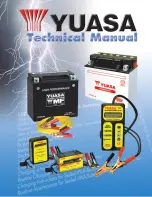
Betriebsanleitung NLG5
User’s manual NLG5
12.2003-NLG5xx_179_ab Nr25
12 / 47
4.5
Betriebsmodi
Operation modes
4.5.1
Mode A
Mode A
Im Mode
A
(
A
utomatisch) lädt das Gerät die Batterie
automatisch nach einem programmierten Ladeprofil. Ein
Ladeprofil besteht aus einem oder mehreren Lade-
Abschnitten. In jedem Abschnitt erfolgt die Ladung nach
einer eigenen I-U-Kennlinie. Die I-U-Kennlinie im ersten
Abschnitt wird durch den Stromwert I
1
und Spannungs-
wert U
1
bestimmt, im zweiten Abschnitt durch I
2
und U
2
usw.
Der Abschnittswechsel - also der Übergang zum nächs-
ten Ladeabschnitt - erfolgt dann, wenn ein oder mehrere
Bedingungen erfüllt sind (z.B. ein bestimmter Ladestrom
wird unterschritten, eine definierte Ladungsmenge wur-
de geladen etc.). Beispielsweise ergibt sich folgender
Ladeverlauf:
•
Im ersten Abschnitt wird die Batterie mit dem kon-
stanten Strom I
1
geladen (I-Phase 1), sofern deren
Spannung kleiner als U
1
ist und das Gerät diesen
Strom zur Verfügung stellt.
•
Nach fortgeschrittener Ladung erreicht die Batterie-
spannung den Wert U
1
, dann wird die Spannung
konstant auf U
1
gehalten, indem das Ladegerät den
Strom reduziert (U-Phase 1).
•
Aufgrund einer oder mehrerer Bedingungen kann
sowohl in der U-Phase als auch schon in der I-
Phase ein Abschnittswechsel erfolgen.
•
Im neuen Abschnitt ist der Strom in der I-Phase in
der Regel kleiner und die Spannung in der U-Phase
grösser als im vorhergehenden Abschnitt (also z.B.
I
2
< I
1
und U
2
> U
1
). Eine Ausnahme bildet der letzte
Abschnitt, wo zur Erhaltungsladung sowohl Strom
als auch Spannung tiefere Werte annehmen als
während des eigentlichen Ladevorgangs.
Weitere Informationen und Beispiele sind in der HELP-
Funktion des kostenlosen Kennlinien-Programms Char-
geStar verfügbar.
In Mode A (
A
utomatic), the battery is charged
automatically according to the programmed charging
profile. A charging profile consists of one or more
sections. In each section the charger uses a separate I-
U-profile. The I-U-profile of the first section is
determined by the current I
1
and the voltage U
1
, the
second section is determined by I
2
and U
2
etc.
Section changing – i.e. passing over from one section to
another – will occur if one or more criteria become true
(e.g. the charging current falls below a certain threshold,
a predefined charge quantity is reached, etc.). The
following example shows a possible charging
procedure:
•
In the first section, the battery is charged with a
constant current I
1
(I-Phase 1) while its voltage
remains below U
1
and the charger can maintain this
current.
•
After a certain time, the battery voltage will reach
the value U
1
; the charging process will then
continue with constant voltage U
1
, thereby reducing
the current (U-Phase 1).
•
If one or more criteria become true, the charger will
quit this section and start the next one. This
changeover can take place in the U-Phase or even
already in the I-Phase.
•
In the new section, the current of the I-Phase is
usually lower and the voltage of the U-Phase higher
than in the preceding section (e.g. I
2
< I
1
and U
2
>
U
1
). An exception is the last section, where voltage
and current are both lower than during the actual
charging process in order to maintain a trickle
charge.
For more Information and examples please see the Help
function of the free software ChargeStar.
Beispiel: Ladung eines 120V Bleiakkus
Example: Charge of a 120V Lead Acid Battery
I
-
Phase 3
U
-
3
U-Phase 2
I-Ph.
2
U-Ph.1
I
-
Phase 1
Abschnitt 1:
Hauptladung
Section1:
Bulk Charge
Abschnitt 2:
Ausgleichsladg.
Section 2:
Equalizing Chg.
Abschnitt 3:
Erhaltungsladung
Section 3:
Float Charge
I
,
U
Zeit
/Time
1h
2h
3h
I
1
U
1
I
2
I
3
U
2
U
3
15A
150V
10A
100V
5A
50V
0
50
100
150
200
0
5
10
15
20
m
ax. L
a
d
e
str
o
m
m
a
x
.C
h
a
rg
e
C
u
rre
n
t
[A
]
Ladespannung /
Charging Voltage [V]
Beispiel für 3 Ladeabschnitte
Example for 3 Charging Sections
Abschnitt 1: Hauptladung
Section 1: Bulk Charge
Abschnitt 2: Ausgleichsladung
Section 2: Equalizing Charge
Abschnitt 3: Erhaltungsladung
Section 3: Float Charge













































